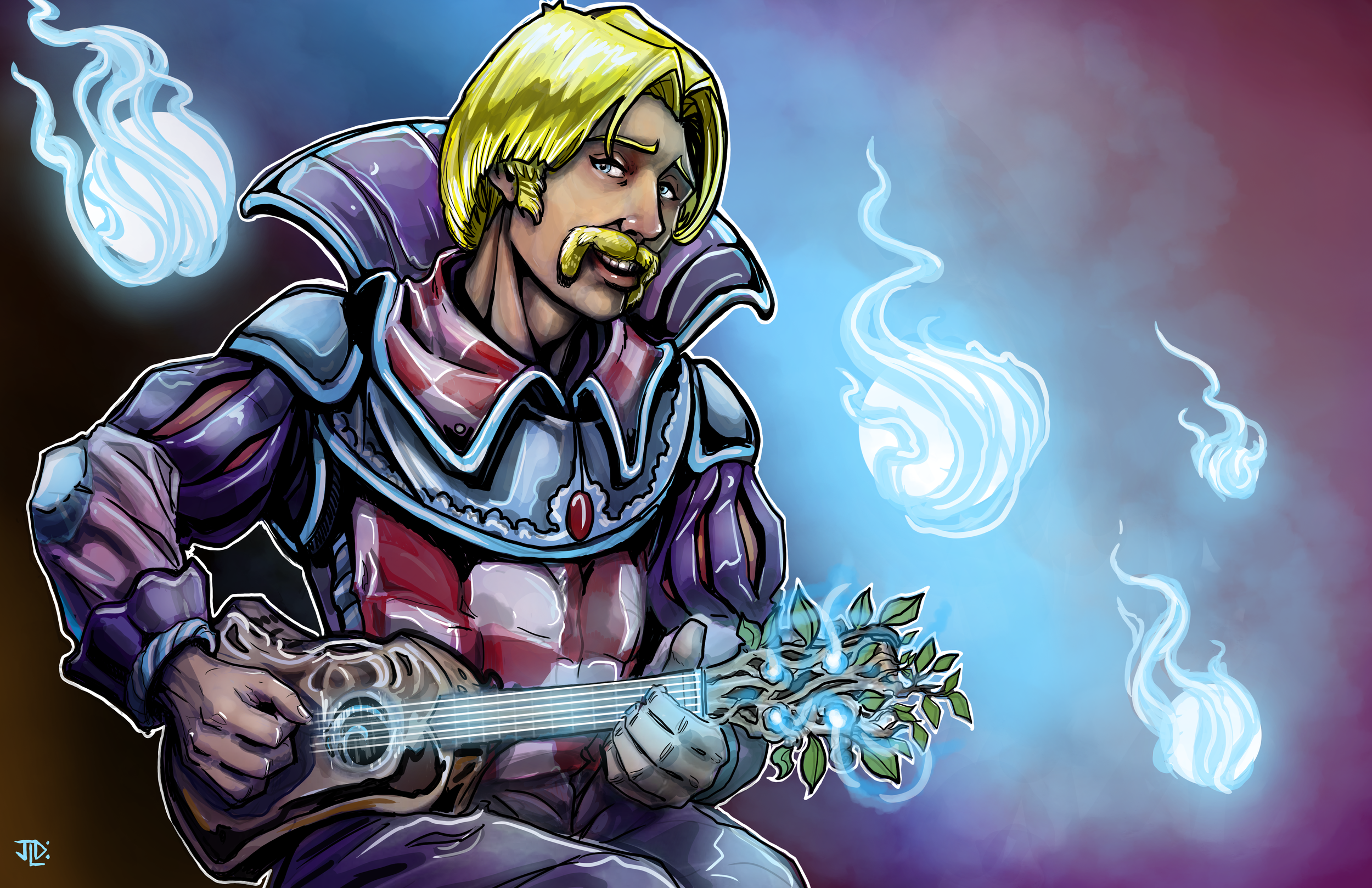Bard College of Swords 5e
Review by Sam West, Twitter: @CrierKobold
Surprising some, bards are close to fighters, barbarians, paladins, and rangers in their martial capabilities thanks to two subclasses: College of Swords and College of Valor, both of which provide you with Extra Attack at 6th level. Each promotes a slightly different direction for builds with Swords delivering a more comprehensive expansion to a specific fantasy.
If you want a bard that stabs things, College of Swords is for you. Extra Attack at 6th level is basically enough to fulfill that fantasy, but they pile on top of that some excellent additions that will give you compelling reasons to stick with the class for the majority of the game.
You may find some struggle in balancing your Ability Score Improvements and feats, as both Dexterity and Charisma are pivotal to these kinds of characters’ performances. If that’s something you don’t mind dealing with and want the glory of 3rd-level spells and Extra Attack in the mid-tiers, Swords can be the college for you.
See Also: Best Feats for Swords Bard
3rd Level: Bonus Proficiencies, Fighting Style, and Blade Flourish
Bonus Proficiencies open up scimitars as a side-grade option for bards otherwise using short-swords, which is fine and all. Medium armor proficiency is honestly lackluster, specifically because College of Swords really wants a high Dexterity, making light armor equal or better in most cases to its medium armor counterparts. When you pick the subclass up, though, it may result in a quick armor swap for a +1 AC, which is fine.
Fighting Styles typically are restricted to fighter, paladin, and ranger; College of Swords lets you stick with bard and get the glory of these passive effects that bolster every attack you make from here on out. Your options are Dueling or Two-Weapon Fighting; because you also get Blade Flourish at this level, and your weapon proficiency offers you the best finesse, light weapons in the game, I tend to prefer Two-Weapon Fighting to get a second attack immediately at a low cost. Dueling can be fine as well, especially if you plan to commit your bonus action down the road to bonus action control-based spells.
Blade Flourish is what separates College of Swords bards from the other two-weapon fighters and duelists out there. You basically transform your inspiration dice pool into “bardic maneuvers” similar to the Battle Master fighter’s martial maneuvers: Defensive, Slashing, and Mobile Flourish. Each empowers a weapon to deal extra damage on hit equal to the die size (which notably does critically hit) and gives you an additional boon from the role.
Defensive Flourish gives you bonus AC equal to the rolled result for the round. Slashing deals bonus damage automatically to another creature as well as the hit creature within 5 feet of you, and Mobile pushes the target 5+ the rolled number of feet and offers you a reaction to move up to your speed to an unoccupied space next to the moved creature.
All three are primarily damage boosts first. Defense tends to be the most used, as getting a massive AC bump for a round is excellent as we all know from how good the Shield spell is. Mobile can be a great way to safely disengage, and Slashing is an easy way to spend dice for bonus damage when you don’t feel you’re being threatened.
Their limit to once a round is entirely reasonable and encourages spacing them out over a handful of fights. They do tend to eat up all your inspiration dice, though, making your core Bardic Inspiration feature feel like it gets eaten up by this existing.
6th Level: Extra Attack
Extra Attack is a core mechanic that scales martial characters in the mid-game. Getting it a level later than fighters and the other martial classes is a bit of a bummer, but ultimately will easily allow your character to participate meaningfully in martial combat.
Extra Attack on bard also means you’ll want to consider taking Magical Secrets to empower your attack rolls on hit damage. Spells like Holy Weapon can trade 5th-level spell slots for 2d8 bonus radiant damage on hit for an hour or as long as you maintain concentration, which can let you hit like a truck.
14th Level: Master’s Flourish
Masters Flourish is the kind of quality-of-life upgrade that deserves to be a capstone. Now, you don’t need to spend bardic inspiration dice to fuel your flourishes. No matter what, every round you’re going to be getting one of your flourishes off regardless of your expended dice pool. You still are incentivized to use the dice on your flourishes when you want more damage or AC, but having a minimum die to fall back on frees up your character to worry less about inspiring allies or spending too many dice in a single fight.
All Together
College of Swords bards are completely reasonable hybrid caster/martial characters. Bard’s spell pool gets expanded by magical secrets to offer you weapon-based spells from warlock, wizard, paladin, and cleric you’re eager to add to your two to three attacks each round. Then also scaling in the upper tiers with potent high-level magic gives you tremendous flexibility. Your spells and weapon attacks won’t always sync up nicely, and you’ll definitely want to consider feats like War Caster, but you can have a blast with two-weapon fighters or duelists made through this subclass for all twenty levels.
Thank you for visiting!
If you’d like to support this ongoing project, you can do so by buying my books, getting some sweet C&C merch, or joining my Patreon.
The text on this page is Open Game Content, and is licensed for public use under the terms of the Open Game License v1.0a.
‘d20 System’ and the ‘d20 System’ logo are trademarks of Wizards of the Coast, Inc.
and are used according to the terms of the d20 System License version 6.0.
A copy of this License can be found at www.wizards.com/d20.



